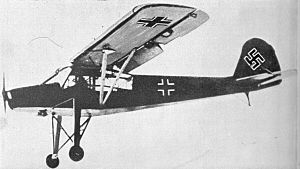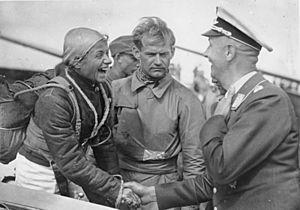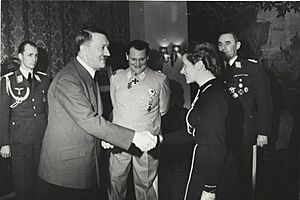Hanna Reitsch facts for kids
Quick facts for kids
Hanna Reitsch
|
|
|---|---|

Hanna Reitsch in 1941
|
|
| Born | 29 March 1912 |
| Died | 24 August 1979 (aged 67) |
| Nationality | German, Austrian |
| Known for | Nazi, Aviator, test pilot
|
| Partner(s) | Robert Ritter von Greim (1945) |
Hanna Reitsch (born March 29, 1912 – died August 24, 1979) was a very famous German pilot and test pilot. She helped test many new German aircraft during World War II. She also received many awards for her amazing flying skills. Hanna Reitsch was one of the last people to meet Adolf Hitler in his bunker in Berlin in April 1945, just before the war ended.
Hanna Reitsch set more than 40 world records for flying. These included records for how high she could fly and how long she could stay in the air, especially in gliding (flying without an engine). She set these records both before and after World War II. In the 1960s, she worked as a flying expert in Ghana. She even started a gliding school there for the country's leader, Kwame Nkrumah.
Contents
Early Life and Flight Training
Hanna Reitsch was born in a town called Hirschberg in Silesia (now part of Poland) on March 29, 1912. Her family was well-off. Her father, Dr. Wilhelm Reitsch, was an eye doctor. Hanna had two siblings, a brother named Kurt and a younger sister named Heidi.
Hanna loved flying from a young age. She began her flight training in 1932 at a gliding school in Grunau. While she was studying medicine in Berlin, she also joined an amateur flying school. There, she learned to fly planes with engines.
Becoming a Professional Pilot
Starting a Career in Aviation (1933–1937)
In 1933, Hanna Reitsch decided to stop studying medicine. She wanted to become a full-time glider pilot and instructor. She was invited by a famous pilot named Wolf Hirth to work at a gliding center.
Hanna also worked as a stunt pilot for a film company. She was very good at it! During this time, she set an unofficial world record for women by staying in a glider for 11 hours and 20 minutes.
In 1934, she joined a trip to South America to study weather patterns for flying. While there, she became the first woman ever to earn the "Silver C Badge" in gliding. This was a very special award for glider pilots.
Later, in 1935, Hanna became a test pilot for the German Research Institute for Gliding (DFS). This meant she would fly new aircraft to see how well they worked. She also learned to fly large, twin-engine planes and perform amazing aerobatics (fancy flying tricks). In 1937, she was given the special title of Flugkapitän (Flight Captain) because she was so skilled. She tested gliders that could carry troops and supplies.
World War II and Test Flying (1937–1945)
In September 1937, Hanna Reitsch was sent to the Luftwaffe (German air force) testing center. She was small, slender, with blonde hair and blue eyes, and always had a smile. Because she was such a talented pilot and looked good in photos, she became a well-known figure in German propaganda during the late 1930s and early 1940s.
Hanna Reitsch made history as the first female helicopter pilot. She was one of the few pilots to fly the Focke-Wulf Fw 61, which was the world's first fully controllable helicopter. In 1938, she even flew this helicopter daily inside a large exhibition hall in Berlin!
She also tested other important aircraft, like the Junkers Ju 87 Stuka (a dive bomber) and the Dornier Do 17 (a light bomber). For her bravery and skill in these tests, she received the Iron Cross, Second Class, from Hitler in 1941.
In 1942, Hanna was asked to test the new rocket-powered Messerschmitt Me 163 Komet. This was a very fast and dangerous aircraft. During her fifth flight in the Me 163, she had a bad crash and was seriously injured. She spent five months in the hospital recovering. After this accident, she received the Iron Cross First Class. She was one of only three women to ever receive this high honor.
In 1943, after a major battle, she visited the Eastern Front to see Luftwaffe units. She flew a small plane called a Fieseler Fi 156 Storch there.
Last Flights in Berlin (1945)

Towards the very end of World War II, in April 1945, Berlin was surrounded by Soviet troops. Hanna Reitsch and General Robert Ritter von Greim flew into the embattled city to meet Hitler in his underground bunker. Hanna landed her Fi 156 Storch on a makeshift airstrip near the Brandenburg Gate.
After their meeting, Hitler gave Hanna and von Greim poison capsules, which she accepted. Early on April 29, 1945, Hanna Reitsch and von Greim flew out of Berlin in an Arado Ar 96 plane. This was the very last plane to leave the city. Soviet troops tried to shoot them down, thinking Hitler might be escaping, but the plane got away safely.
After the War (1945)
Hanna Reitsch was captured by U.S. military officers soon after leaving Berlin. She was held for 18 months. Her family, who had moved to Salzburg to escape the Soviet troops, faced a terrible tragedy. Her father, fearing they would be sent back to Soviet-controlled areas, killed his family and himself.
Life After World War II
Returning to Flight (1945–1979)
After her release, Hanna Reitsch settled in Frankfurt, Germany. For a few years after the war, Germans were not allowed to fly planes with engines. However, gliding was soon allowed again, and Hanna quickly returned to it.
In 1952, she won a bronze medal at the World Gliding Championships in Spain. She was the first woman to compete in this event. In 1955, she became the German gliding champion. She continued to break records, including the women's altitude record in 1957.
In 1959, the Prime Minister of India, Jawaharlal Nehru, invited Hanna to help start a gliding center in his country. She even flew with him over New Delhi. In 1961, the President of the United States, John F. Kennedy, invited her to the White House.
From 1962 to 1966, Hanna Reitsch lived in Ghana, a country in Africa. The Ghanaian President, Kwame Nkrumah, invited her to start the first national gliding school in Black Africa. She worked closely with the government and the armed forces. The West German government supported her as a technical adviser. She earned another special gliding award, the FAI Diamond Badge, in 1970.
Hanna Reitsch's experiences in Ghana changed her views on race. She said that before, she would never have thought of a black person as a friend. But in Ghana, she felt guilty about her past "arrogance" and learned to see people differently.
Throughout the 1970s, Hanna continued to break gliding records. She set the "Women's Out and Return World Record" twice, flying long distances along the Appalachian Mountains in the United States. She also finished first in the women's section of the first world helicopter championships.
Death
Hanna Reitsch passed away from a heart attack in Frankfurt on August 24, 1979, at the age of 67. She never married. She is buried in her family's grave in Salzburg.
Amazing Awards and World Records
Hanna Reitsch achieved many incredible feats in her flying career:
- 1932: Set a women's gliding endurance record (staying in the air for 5.5 hours).
- 1936: Set a women's gliding distance record (flying 305 kilometers).
- 1937: Became the first woman to fly a glider across the Alps mountains.
- 1937: Was the first woman in the world to be promoted to Flight Captain.
- 1937: Became the first woman to fly a helicopter (the Fa 61).
- 1937: Set a world distance record in a helicopter (109 kilometers).
- 1938: Was the first person to fly a helicopter (Fa 61) inside a large enclosed building (the Deutschlandhalle).
- 1938: Won a German national gliding competition.
- 1939: Set a women's world record in gliding for point-to-point flight.
- 1943: Became the first woman to pilot a rocket plane (Messerschmitt Me 163) while in the Luftwaffe. She survived a bad crash and received the Iron Cross First Class because of it.
- 1944: Was the first woman in the world to pilot a jet aircraft during tests of the Messerschmitt Me 262 and Heinkel He 162.
- 1952: Won third place in the World Gliding Championships in Spain.
- 1955: Became the German gliding champion.
- 1956: Set a German gliding distance record (370 kilometers).
- 1957: Set a German gliding altitude record (6,848 meters).
Books by Hanna Reitsch
- Fliegen, mein Leben (Flying, My Life) - Her autobiography.
- Ich flog in Afrika für Nkrumahs Ghana (I Flew in Africa for Nkrumah's Ghana) - About her time in Ghana.
- Das Unzerstörbare in meinem Leben (The Indestructible in My Life).
- Höhen und Tiefen. 1945 bis zur Gegenwart (Highs and Lows. 1945 to the Present).
Images for kids
-
A Fieseler Fi 156 Storch similar to the one Reitsch landed in the Tiergarten near the Brandenburg Gate during the Battle of Berlin
See Also
 In Spanish: Hanna Reitsch para niños
In Spanish: Hanna Reitsch para niños
- Rhön-Rossitten Gesellschaft








